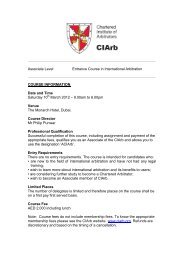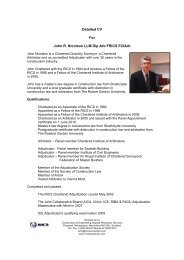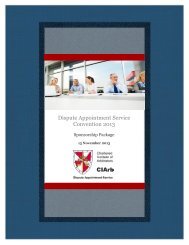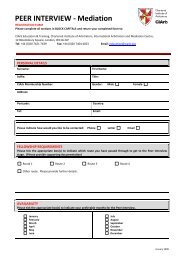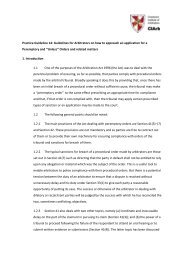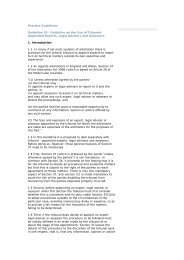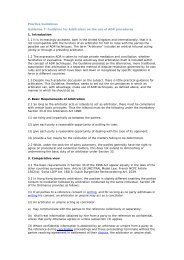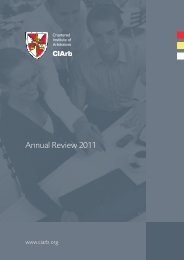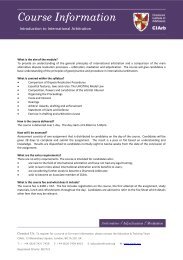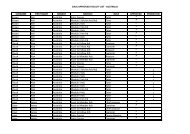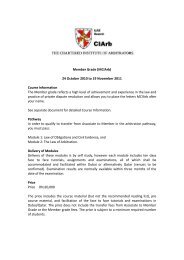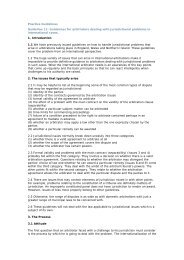Annual Report 2009 - Chartered Institute of Arbitrators
Annual Report 2009 - Chartered Institute of Arbitrators
Annual Report 2009 - Chartered Institute of Arbitrators
- No tags were found...
You also want an ePaper? Increase the reach of your titles
YUMPU automatically turns print PDFs into web optimized ePapers that Google loves.
<strong>Annual</strong> <strong>Report</strong> <strong>2009</strong>INTERNATIONAL BRANCH REPORTSAUSTRALIA BranchChairman: Derek MinusThe principal Australia Branch <strong>of</strong>ficers for <strong>2009</strong> were: DerekMinus (Chairman), Albert Monichino and Alan Limbury (Vice-Chairs), Michael Sanig, (Honorary Treasurer) and JohnWakefield (Honorary Secretary).The past year has been a pivotal one for the AustraliaBranch, with both the Australian International Arbitration Actand the domestic Commercial Arbitration Acts the subject <strong>of</strong>wide-ranging and substantial review. The Federal Governmenthas brought the International Act up to date to ensure bestpractice, and the state-based uniform Arbitration Acts havebeen completely redrafted, in line with the Model Law.In addition to its focus on modernising the arbitrationregime, the Federal and New South Wales governmentshave also been active in reviewing civil litigation processesand calling for responses to initiatives to increase the use <strong>of</strong>alternative dispute resolution procedures, including:◆ National Alternative Dispute Resolution Advisory Council(NADRAC)Inquiry in to ADR and Civil Proceedings◆ NSW Government ADR Blueprint◆ Federal Government Strategic Review <strong>of</strong> Access toJustice◆ NADRAC Reference on the Integrity <strong>of</strong> ADR processesThese reviews have provided the best opportunity for the<strong>Institute</strong> to put forward proposals for improved use <strong>of</strong> arbitralprocedures. The branch has played a leadership role inrespect <strong>of</strong> these reviews, providing detailed submissions,advocating policy positions and recommendingamendments.For the review <strong>of</strong> the International Arbitration Act, I wouldparticularly like to note the contributions <strong>of</strong> Albert Monichino,Jim Creer, Alan Limbury, John Wakefield and Malcolm Holmeswho assisted me in the preparation <strong>of</strong> this submission.For the review <strong>of</strong> the Uniform Commercial Arbitration Acts, Iwould particularly like to note the efforts <strong>of</strong> Albert Monichino,John Wakefield and Peter Megens who assisted me as anexpert panel in the preparation <strong>of</strong> this submission. In orderto maximise its effectiveness, a single submission wasprovided to the Standing Committee <strong>of</strong> Attorneys Generalby the branch in conjunction with the <strong>Institute</strong> <strong>of</strong> <strong>Arbitrators</strong>and Mediators Australia, jointly signed by their President,The Hon Michael Kirby AC CMG and myself.For the NADRAC investigation into the use <strong>of</strong> ADR in civilproceedings, branch committee members met with the fullAdvisory Council to make submissions. Although the finalreport, The Resolve to Resolve – Embracing ADR to ImproveAccess to Justice in the Federal Jurisdiction, embraced thepractice <strong>of</strong> arbitration, discussion <strong>of</strong> arbitration at a federallevel was deferred due to the review <strong>of</strong> the InternationalArbitration Act.Flowing from the work done on the joint development <strong>of</strong>submissions for government reviews and due to thesignificant personal efforts <strong>of</strong> Ian Nosworthy, a member <strong>of</strong>branch committee and a former President <strong>of</strong> IAMA, amemorandum <strong>of</strong> understanding was signed between thethree major arbitration bodies in Australia.This memorandum, which records the agreement to“maximise the use <strong>of</strong> resources through mutual cooperation,share expertise and efforts in education, and to advancearbitration (both domestic and international) and otheralternative dispute resolution methods in Australia”, wasjointly signed by the three Presidents, The Hon Michael KirbyAC CMG <strong>of</strong> IAMA, Doug Jones AM <strong>of</strong> ACICA and myself, ata special ceremony, in December <strong>2009</strong>.The branch also continued its focus this year on a number<strong>of</strong> strategic policy objectives, including:◆ to ensure that membership <strong>of</strong> the <strong>Institute</strong> is recognisedas a qualification which is <strong>of</strong> value domestically andinternationally;◆ to provide leadership in accreditation and policydevelopment in domestic and international commercialdispute resolution;◆ to raise awareness <strong>of</strong> the advantages <strong>of</strong> arbitration andmediation as processes for resolving disputes;◆ to increase our membership at each level <strong>of</strong> the <strong>Institute</strong>.In line with these strategic objectives, a variety <strong>of</strong> activitiesdirected to the branch’s priorities, principally educational,were undertaken.The branch has issued a quarterly newsletter since thelaunch <strong>of</strong> the ADR <strong>Report</strong>er in October 2006 which hascontinued to be a source <strong>of</strong> appreciation from themembership. As well as providing members with informationabout upcoming events, the newsletter has also providedupdates on cases that impact the practice <strong>of</strong> arbitration inAustralia, the proposed legislative changes and generalcomment on possible improvements in the practice <strong>of</strong>arbitration and other forms <strong>of</strong> dispute resolution.The branch held its Diploma in International CommercialPage 16CIArb <strong>Annual</strong> <strong>Report</strong> <strong>2009</strong>: International Branch <strong>Report</strong>s



